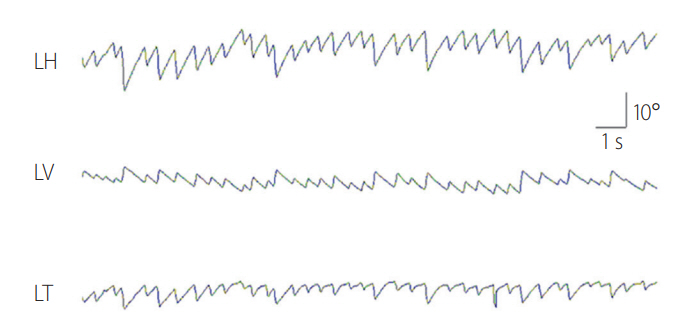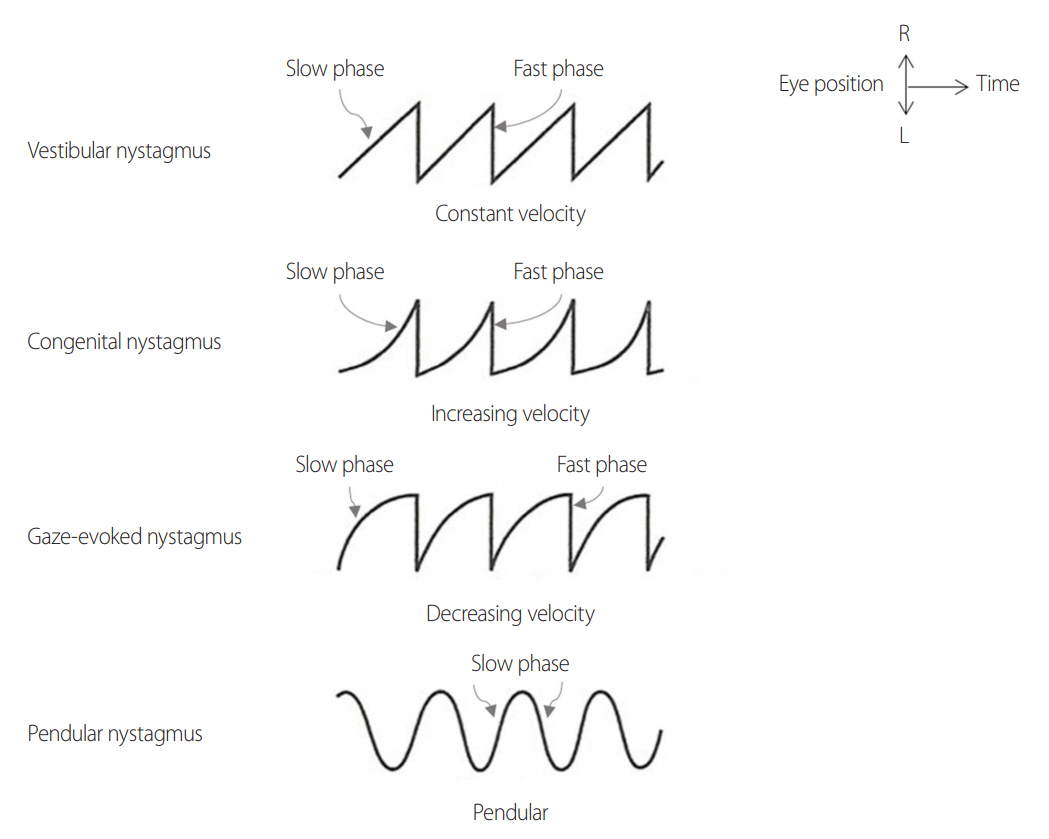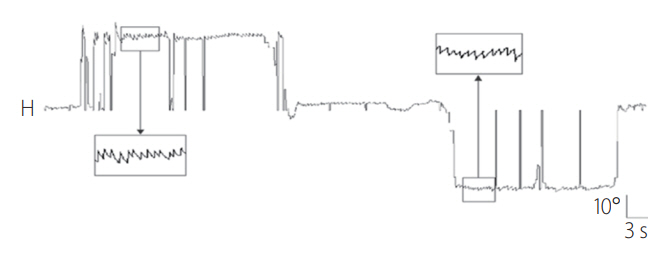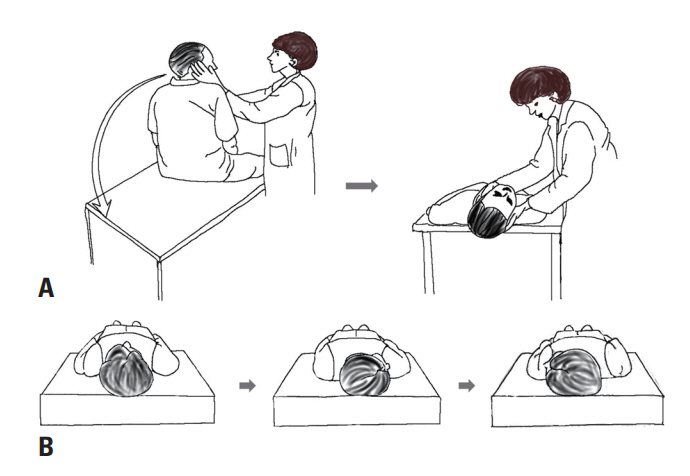Ann Clin Neurophysiol.
2023;25(1):10-18. 10.14253/acn.2023.25.1.10.
Recording and interpretation of ocular movements: spontaneous and induced nystagmus
- Affiliations
-
- 1Department of Neurology, Jeonbuk National University Hospital, Jeonbuk National University School of Medicine, Jeonju, Korea
- 2Research Institute of Clinical Medicine of Jeonbuk National University-Jeonbuk National University Hospital, Jeonju, Korea
- 3Department of Neurology, Pusan National University Hospital, Pusan National University School of Medicine and Biomedical Research Institute, Busan, Korea
- 4Department of Neurology, The Catholic University of Korea Incheon St. Mary's Hospital, Incheon, Korea
- KMID: 2541817
- DOI: http://doi.org/10.14253/acn.2023.25.1.10
Abstract
- The ultimate purpose of eye movement is to maintain clear vision by ensuring that images of observed objects are focused on the fovea in the retina. Accurate evaluation of ocular movements, including nystagmus and saccadic intrusions, provides very useful information for determining the overall function and abnormality of the complex oculomotor system, from the peripheral vestibular system to the cerebrum. Eye movement tests are therefore essential for the accurate diagnosis of patients who complain of dizziness and imbalance. They help to predict lesion locations from the peripheral vestibular system to the central cerebral cortex and play an important role in differentiation from other diseases. The methodology of recording and interpreting ocular movements using video-oculography are described in this review article.
Figure
Reference
-
1. Downey DL, Leigh RJ. Eye movements: pathophysiology, examination and clinical importance. J Neurosci Nurs. 1998; 30:15–22. quiz 23-24.
Article2. Leigh RJ, Zee DS. The neurology of eye movements. 5th ed. New York: Oxford University Press;2015. p. 10–12.3. Westheimer G. Mechanism of saccadic eye movements. AMA Arch Ophthalmol. 1954; 52:710–724.
Article4. Ilg UJ. Slow eye movements. Prog Neurobiol. 1997; 53:293–329.
Article5. Tatler BW, Wade NJ. On nystagmus, saccades, and fixations. Perception. 2003; 32:167–184.
Article6. Haslwanter T, Clarke AH. Eye movement measurement: electro-oculography and video-oculography. Handbook of Clinical Neurophysiology. 2010; 9:61–79.7. Young LR, Sheena D. Survey of eye movement recording methods. Behavior Research Methods & Instrumentation. 1975; 7:397–429.8. Robinson DA. A method of measuring eye movemnent using a scieral search coil in a magnetic field. TBME. 1963; 10:137–145.9. Strupp M, Glasauer S, Jahn K, Schneider E, Krafczyk S, Brandt T. Eye movements and balance. Ann N Y Acad Sci. 2003; 1004:352–358.10. Baloh RW. Differentiating between peripheral and central causes of vertigo. Otolaryngol Head Neck Surg. 1998; 119:55–59.11. Serra A, Leigh RJ. Diagnostic value of nystagmus: spontaneous and induced ocular oscillations. J Neurol Neurosurg Psychiatry. 2002; 73:615–618.12. Robinson DA, Zee DS, Hain TC, Holmes A, Rosenberg LF. Alexander’s law: its behavior and origin in the human vestibulo-ocular reflex. Ann Neurol. 1984; 16:714–722.
Article13. Strupp M, Hüfner K, Sandmann R, Zwergal A, Dieterich M, Jahn K, et al. Central oculomotor disturbances and nystagmus: a window into the brainstem and cerebellum. Dtsch Arztebl Int. 2011; 108:197–204.14. Tilikete C, Pélisson D. Ocular motor syndromes of the brainstem and cerebellum. Curr Opin Neurol. 2008; 21:22–28.
Article15. Keller EL, Heinen SJ. Generation of smooth-pursuit eye movements: neuronal mechanisms and pathways. Neurosci Res. 1991; 11:79–107.
Article16. Bedell HE, Stevenson SB. Eye movement testing in clinical examination. Vision Res. 2013; 90:32–37.
Article17. Lang EE, McConn Walsh R. Vestibular function testing. Ir J Med Sci. 2010; 179:173–178.
Article18. Cannon SC, Robinson DA. Loss of the neural integrator of the oculomotor system from brain stem lesions in monkey. J Neurophysiol. 1987; 57:1383–1409.
Article19. Katsarkas A, Smith H, Galiana H. Head-shaking nystagmus (HSN): the theoretical explanation and the experimental proof. Acta Otolaryngol. 2000; 120:177–181.
Article20. Ohki M, Murofushi T, Nakahara H, Sugasawa K. Vibration-induced nystagmus in patients with vestibular disorders. Otolaryngol Head Neck Surg. 2003; 129:255–258.
Article21. Barber HO. Positional nystagmus. Otolaryngol Head Neck Surg. 1984; 92:649–655.
Article22. Kavanagh KT, Babin RW. Definitions and types of nystagmus and calculations. Ear Hear. 1986; 7:157–166.
Article23. Barnes GR. A procedure for the analysis of nystagmus and other eye movements. Aviat Space Environ Med. 1982; 53:676–682.
Article24. Rucker JC. An update on acquired nystagmus. Semin Ophthalmol. 2008; 23:91–97.
Article25. Levo H, Aalto H, Petteri Hirvonen T. Nystagmus measured with video-oculography: methodological aspects and normative data. ORL J Otorhinolaryngol Relat Spec. 2004; 66:101–104.
Article26. Karatas M. Central vertigo and dizziness: epidemiology, differential diagnosis, and common causes. Neurologist. 2008; 14:355–364.27. Rett D. Gaze-evoked nystagmus: a case report and literature review. Optometry. 2007; 78:460–464.
Article28. Abel LA, Dell’osso LF, Daroff RB. Analog model for gaze-evoked nystagmus. IEEE Trans Biomed Eng. 1978; 25:71–75.
Article29. Robinson DA. Eye movement control in primates. The oculomotor system contains specialized subsystems for acquiring and tracking visual targets. Science. 1968; 161:1219–1224.30. Robinson DA. The use of control systems analysis in the neurophysiology of eye movements. Annu Rev Neurosci. 1981; 4:463–503.
Article31. Lee H, Kim HA. Anatomical structure responsible for direction changing bilateral gaze-evoked nystagmus in patients with unilateral cerebellar infarction. Medicine (Baltimore). 2020; 99:e19866.
Article32. Abadi RV. Mechanisms underlying nystagmus. J R Soc Med. 2002; 95:231–234.
Article33. Abel LA, Parker L, Daroff RB, Dell’Osso LF. End-point nystagmus. Invest Ophthalmol Vis Sci. 1978; 17:539–544.34. Stahl JS, Averbuch-Heller L, Leigh RJ. Acquired nystagmus. Arch Ophthalmol. 2000; 118:544–549.
Article35. Eizenman M, Cheng P, Sharpe JA, Frecker RC. End-point nystagmus and ocular drift: an experimental and theoretical study. Vision Res. 1990; 30:863–877.
Article36. Eizenman M, Sharpe JA. End point, gaze-evoked, and rebound nystagmus. In : Sharpe JA, Barber HO, editors. The vestibulo-ocular reflex and vertigo. New York: Raven Press;1993. p. 257–267.37. Kamei T. Two types of head-shaking tests in vestibular examination. Acta Otolaryngol Suppl. 1988; 458:108–112.
Article38. Asawavichiangianda S, Fujimoto M, Mai M, Desroches H, Rutka J. Significance of head-shaking nystagmus in the evaluation of the dizzy patient. Acta Otolaryngol Suppl. 1999; 540:27–33.39. Minor LB, Haslwanter T, Straumann D, Zee DS. Hyperventilation-induced nystagmus in patients with vestibular schwannoma. Neurology. 1999; 53:2158–2168.
Article40. Kheradmand A, Zee DS. The bedside examination of the vestibulo-ocular reflex (VOR): an update. Rev Neurol (Paris). 2012; 168:710–719.
Article41. Parnes LS, Agrawal SK, Atlas J. Diagnosis and management of benign paroxysmal positional vertigo (BPPV). CMAJ. 2003; 169:681–693.42. Schmal F, Stoll W. Diagnosis and management of benign paroxysmal positional vertigo. Laryngorhinootologie. 2002; 81:368–380.43. Singh J, Bhardwaj B. Lateral semicircular canal BPPV…are we still ignorant? Indian J Otolaryngol Head Neck Surg. 2020; 72:175–183.
Article44. Vannucchi P, Giannoni B, Pagnini P. Treatment of horizontal semicircular canal benign paroxysmal positional vertigo. J Vestib Res. 1997; 7:1–6.
Article45. Kim CH, Kim YG, Shin JE, Yang YS, Im D. Lateralization of horizontal semicircular canal canalolithiasis and cupulopathy using bow and lean test and head-roll test. Eur Arch Otorhinolaryngol. 2016; 273:3003–3009.
Article46. Macdonald NK, Kaski D, Saman Y, Al-Shaikh Sulaiman A, Anwer A, Bamiou DE. Central positional nystagmus: a systematic literature review. Front Neurol. 2017; 8:141.
Article47. Lemos J, Strupp M. Central positional nystagmus: an update. J Neurol. 2022; 269:1851–1860.
Article48. Büttner U, Helmchen C, Brandt T. Diagnostic criteria for central versus peripheral positioning nystagmus and vertigo: a review. Acta Otolaryngol. 1999; 119:1–5.
Article
- Full Text Links
- Actions
-
Cited
- CITED
-
- Close
- Share
- Similar articles
-
- Nystagmus as a Sign of Labyrinthine Disorders: Three-Dimensional Analysis of Nystagmus
- Recording and interpretation of ocular movements: saccades, smooth pursuit, and optokinetic nystagmus
- Three Dimensional Measurement of Spontaneous, Positional, Positioning(Dix-Hallpike) and Post Head Shaking Nystagmus in Cats
- Abnormal Eye Movements in Parkinsonism and Movement Disorders
- Update on Nystagmus and Other Ocular Oscillations





